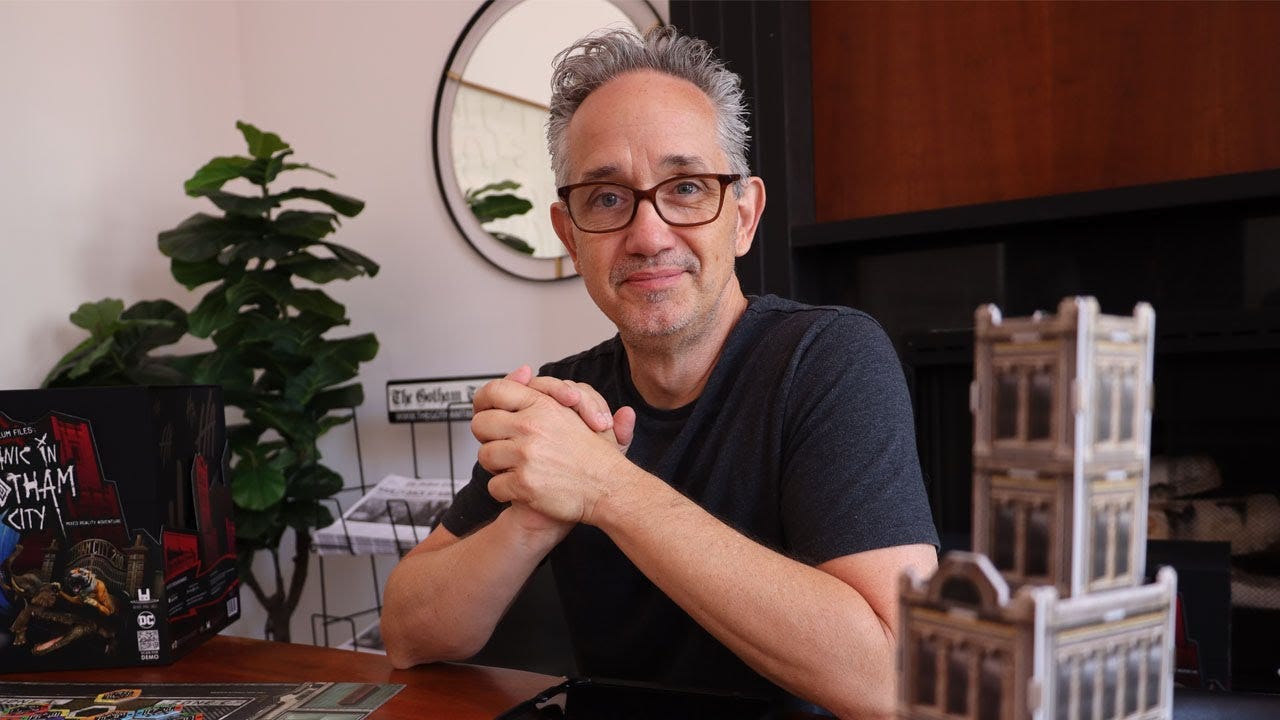About Michael Borys
Michael Borys stands out in the game design landscape for his exceptional blend of interactive design expertise and storytelling prowess. He has worked on some of the world's biggest brands, including Disney, Warner Brothers, Microsoft, Activision, Paramount, and Sony. As Vice President of Interaction Design at 42 Entertainment, he led the creation of groundbreaking experiences, earning consecutive Cannes Lions Grand Prix Awards for his innovative Alternate Reality Games. These games, which spanned franchises like Batman and Call of Duty, engaged millions globally. Michael's work covers various mediums, from theme park attractions to cutting-edge augmented reality and location-based entertainment projects. Beyond his design career, Michael is a magician member of The Magic Castle in Hollywood. He is celebrated for his immersive show “The 49 Boxes,” which has captivated audiences across the United States. Borys' dedication to authenticity, magic, and history, combined with his love for storytelling, imbues his creations with a truly unbelievable level of immersion. His newest experience is a tabletop game called The Arkham Asylum Files for the company Infinite Rabbit Holes. Having him share his insights and experiences on the Think Like A Game Designer Podcast was a privilege.
Ah-Ha! Justin’s Takeaways
Player experience is the most important metric. I’ve said this to my team and students numerous times. About halfway through the episode, Michael introduces the concept of three player types based on the depth of their interaction with a game: The Wader, The Swimmer, and The Diver. The Wader engages with the game from a distance, The Swimmer actively partakes in the experience, and The Diver immerses themselves deeply, exploring every intricacy of the game. This framework offers a valuable perspective for designers aiming to enrich the experience of all players.
Sprinkle just enough truth in your fiction to make it come alive. By using real-world stories as templates, real-life objects with history, and paying attention to ambiance, Michael is able to immerse players in the story of a game more powerfully than most designers I know. Whether your medium is tabletop, VR, or an ARG, look for where you can anchor elements of the natural world into your games to make magic happen.
Always have a backup plan. Live events, magic, and role-playing games all have one thing in common—unpredictability. Your audience/players won’t always do what you want them to, so you must have backup plans! Have hooks pre-prepared to bring players back to the main plot, have clues ready to help out a floundering team in an escape room, or introduce some misdirection to make it seem like “you knew all along” what would happen. Even in classic tabletop games, you can apply this lesson by building in “silver bullets" to counter a strategy you might not have expected would be good after your game is released.
Show Notes
Building Experiences the Power of Objects (00:04:00)
“Objects have power.”
In the first segment, Michael shares his origin story, focusing on the power and history of objects and the narratives they hold. He explores how this captivation with objects propelled him into a multifaceted career in art, story development, and various other creative endeavors, including animation and introducing gamified experiences at Disney Theme Parks. The discussion also touches on what it entails to be at the cutting edge of an industry. Michael's journey led him to work on augmented reality (AR) campaigns for major intellectual properties like The Dark Knight and Tron. The segment features an amazing tale about an underground vaudevillian society in Los Angeles, for which Michael developed an interactive experience—a story that is a must-hear!
Contingency Plans for Immersive Community Games (00:18:12)
“If there was one thing we learned about—it was designing contingencies.”
Michael discusses his time working with Jordan Weisman and Elan Lee at 42 Entertainment. He emphasizes the importance of adaptability in storytelling and game design, especially in the face of unforeseen challenges. Michael highlights the need for contingency plans in case of setbacks and stresses the team's ability to improvise effectively. He describes his goals for a game: as personal as possible, empowering, and community-based.
Citizens of an Experience (00:30:00)
“One of the most important things for us in game design is letting the players feel like they are citizens of whatever experience we are playing.”
We further explored the topic by discussing the creation of games for Disney theme parks and San Diego Comic-Con. Michael emphasized the significance of immersing players in the game world, citing examples like issuing citizenship cards for Gotham City during the renowned Dark Knight Campaign. This approach underlines his commitment to enhancing the player experience by blurring the lines between game and reality. This segment has some wild examples that you have to hear to believe.
We delve further into the topic of phone-centric alternate reality games, emphasizing the importance of having a clear "why" to draw people into the world. Michael portrays the app as a means to support and check your creative work rather than serving as the sole tool for the entire experience.
VR vs. AR (00:49:30)
“What’s the new technology? How do you leverage it? How do you make it meaningful? And how do you not make something that’s gimmicky?”
Michael discusses an alternate reality experience as integrating personal elements, like your cat, sibling, home, or city, into a virtual world. This contrasts with virtual reality, where your personal world is replaced by a completely new one. Our conversation explores how these concepts might merge, creating a new frontier in gaming and experiential design.
Magic, Storytelling, and Games (00:57:00)
“The best magic is all about storytelling.”
In our discussion on storytelling in games and alternate-reality experiences, Michael emphasizes the use of historical elements that are both fascinating and researchable. This blend of fact and fiction creates a seed of truth in the game, adding a layer of humanity and enabling players to explore and research, enhancing their engagement with the game's world. Michael shares the story of the Mission Inn, explaining how its rich history inspired him to develop an innovative story and game centered around this unique location in California. Objects from historical figures who stayed in the hotel make appearances as clues to a larger game. It’s an incredible story that truly blends fact and fiction.
Show Links:
The Arkham Asylum Files
https://shop.infiniterabbitholes.com/















Share this post